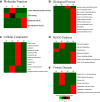Novel proteome and acetylome of Bemisia tabaci Q in response to Cardinium infection
- PMID: 29976144
- PMCID: PMC6034306
- DOI: 10.1186/s12864-018-4907-3
Novel proteome and acetylome of Bemisia tabaci Q in response to Cardinium infection
Abstract
Background: It has become increasingly clear that symbionts have crucial evolutionary and ecological ramifications for their host arthropods. However, little is known whether these symbiont infections influence the proteome and lysine acetylome of their host arthropods. Here we performed experiments to investigate the proteomes and acetylomes of Cardinium-infected (C*+) and -uninfected (C-) Bemisia tabaci Q with identical backgrounds, through the combination of affinity enrichment and high-resolution LC-MS/MS analysis.
Results: Of the 3353 proteins whose levels were quantitated in proteome, a total of 146 proteins dividing into 77 up-regulated and 69 down-regulated proteins were discovered to be differentially expressed as having at least a 1.2-fold change when C*+ strain was compared with C- strain. Furthermore, a total of 528 lysine acetylation sites in 283 protein groups were identified, among which 356 sites in 202 proteins were quantified. The comparison of acetylomes revealed 30 sites in 26 lysine acetylation proteins (Kac) were quantified as up-regulated targets and 35 sites in 29 Kac proteins were quantified as down-regulated targets. Functional analysis showed that these differentially expressed proteins and Kac proteins were mainly involved in diverse physiological processes related to development, immune responses and energy metabolism, such as retinol metabolism, methane metabolism and fatty acid degradation. Notably, protein interaction network analyses demonstrated widespread interactions modulated by protein acetylation.
Conclusion: Here we show the proteome and acetylom of B. tabaci Q in response to the symbiont Cardinium infection. This is the first study to utilize the tool of acetylome analysis for revealing physiological responses of arthropods to its symbiont infection, which will provide an important resource for exploring the arthropod-symbiont interaction.
Keywords: Acetylomes; Bemisia tabaci Q; Cardinium; Physiological response; Proteomes.
Conflict of interest statement
Ethics approval and consent to participate
The cotton plants variety Lu-Mian-Yan 21 used in this study was produced by Shandong Cotton Research Center, Shandong, China and was widely cultivated in the north of China. The cultivar has been approved by the National Crop Variety Appraisal Committee (Number: 2005011). A voucher specimen of this material has not been deposited in a publicly available herbarium. Experimental research on Lu-Mian-Yan 21, including collection of this plant material, complies with institutional, national and international guidelines.
Consent for publication
Not applicable.
Competing interests
The authors declare that they have no competing interests.
Publisher’s Note
Springer Nature remains neutral with regard to jurisdictional claims in published maps and institutional affiliations.
Figures






Similar articles
-
A comprehensive atlas of lysine acetylome in onion thrips (Thrips tabaci Lind.) revealed by proteomics analysis.J Proteomics. 2019 Sep 15;207:103465. doi: 10.1016/j.jprot.2019.103465. Epub 2019 Jul 22. J Proteomics. 2019. PMID: 31344497
-
Genome-Wide Profiling of Cardinium-Responsive MicroRNAs in the Exotic Whitefly, Bemisia tabaci (Gennadius) Biotype Q.Front Physiol. 2018 Nov 12;9:1580. doi: 10.3389/fphys.2018.01580. eCollection 2018. Front Physiol. 2018. PMID: 30483149 Free PMC article.
-
Comprehensive profiling of lysine acetylation suggests the widespread function is regulated by protein acetylation in the silkworm, Bombyx mori.Proteomics. 2015 Sep;15(18):3253-66. doi: 10.1002/pmic.201500001. Epub 2015 Jul 2. Proteomics. 2015. PMID: 26046922
-
An integrated perspective and functional impact of the mitochondrial acetylome.Expert Rev Proteomics. 2014 Jun;11(3):383-94. doi: 10.1586/14789450.2014.899470. Epub 2014 Mar 24. Expert Rev Proteomics. 2014. PMID: 24661243 Review.
-
Acetylome regulation by sirtuins in the brain: from normal physiology to aging and pathology.Curr Pharm Des. 2013;19(38):6823-38. doi: 10.2174/1381612811319380014. Curr Pharm Des. 2013. PMID: 23530517 Review.
Cited by
-
The Susceptibility of Bemisia tabaci Mediterranean (MED) Species to Attack by a Parasitoid Wasp Changes between Two Whitefly Strains with Different Facultative Endosymbiotic Bacteria.Insects. 2023 Oct 11;14(10):808. doi: 10.3390/insects14100808. Insects. 2023. PMID: 37887820 Free PMC article.
-
Cardinium disrupts Wolbachia-host dynamics in the domestic mite Tyrophagus putrescentiae: evidence from manipulative experiments.mSystems. 2025 May 20;10(5):e0176924. doi: 10.1128/msystems.01769-24. Epub 2025 Apr 18. mSystems. 2025. PMID: 40249197 Free PMC article.
-
Novel Proteome and N-Glycoproteome of the Thermophilic Fungus Chaetomium thermophilum in Response to High Temperature.Front Microbiol. 2021 Jun 7;12:644984. doi: 10.3389/fmicb.2021.644984. eCollection 2021. Front Microbiol. 2021. PMID: 34163440 Free PMC article.
-
Whitefly endosymbionts: IPM opportunity or tilting at windmills?J Pest Sci (2004). 2022;95(2):543-566. doi: 10.1007/s10340-021-01451-7. Epub 2021 Nov 2. J Pest Sci (2004). 2022. PMID: 34744550 Free PMC article. Review.
-
Win by Quantity: a Striking Rickettsia-Bias Symbiont Community Revealed by Seasonal Tracking in the Whitefly Bemisia tabaci.Microb Ecol. 2021 Feb;81(2):523-534. doi: 10.1007/s00248-020-01607-5. Epub 2020 Sep 23. Microb Ecol. 2021. PMID: 32968841
References
-
- Engelstädter J, Hurst GDD. The ecology and evolution of microbes that manipulate host reproduction. Annu Rev Ecol Evol Syst. 2009;40:127–149. doi: 10.1146/annurev.ecolsys.110308.120206. - DOI
MeSH terms
Substances
Grants and funding
LinkOut - more resources
Full Text Sources
Other Literature Sources

